学术论文与写作
什么是学术论文如何写作学术论文
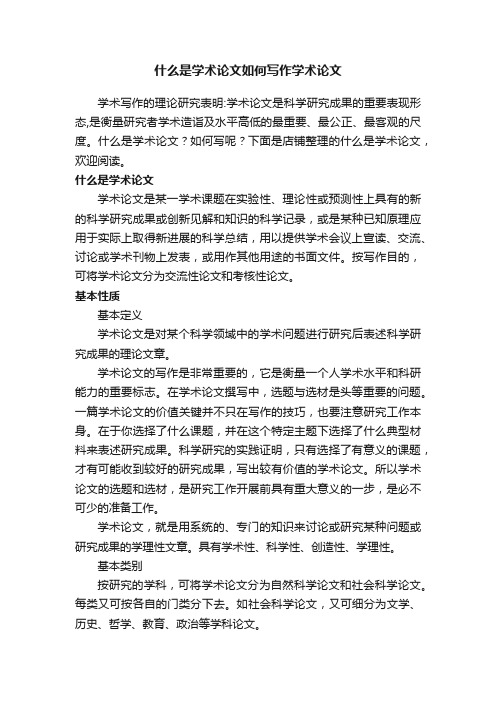
什么是学术论文如何写作学术论文学术写作的理论研究表明:学术论文是科学研究成果的重要表现形态,是衡量研究者学术造诣及水平高低的最重要、最公正、最客观的尺度。
什么是学术论文?如何写呢?下面是店铺整理的什么是学术论文,欢迎阅读。
什么是学术论文学术论文是某一学术课题在实验性、理论性或预测性上具有的新的科学研究成果或创新见解和知识的科学记录,或是某种已知原理应用于实际上取得新进展的科学总结,用以提供学术会议上宣读、交流、讨论或学术刊物上发表,或用作其他用途的书面文件。
按写作目的,可将学术论文分为交流性论文和考核性论文。
基本性质基本定义学术论文是对某个科学领域中的学术问题进行研究后表述科学研究成果的理论文章。
学术论文的写作是非常重要的,它是衡量一个人学术水平和科研能力的重要标志。
在学术论文撰写中,选题与选材是头等重要的问题。
一篇学术论文的价值关键并不只在写作的技巧,也要注意研究工作本身。
在于你选择了什么课题,并在这个特定主题下选择了什么典型材料来表述研究成果。
科学研究的实践证明,只有选择了有意义的课题,才有可能收到较好的研究成果,写出较有价值的学术论文。
所以学术论文的选题和选材,是研究工作开展前具有重大意义的一步,是必不可少的准备工作。
学术论文,就是用系统的、专门的知识来讨论或研究某种问题或研究成果的学理性文章。
具有学术性、科学性、创造性、学理性。
基本类别按研究的学科,可将学术论文分为自然科学论文和社会科学论文。
每类又可按各自的门类分下去。
如社会科学论文,又可细分为文学、历史、哲学、教育、政治等学科论文。
按研究的内容,可将学术论文分为理论研究论文和应用研究论文。
理论研究,重在对各学科的基本概念和基本原理的研究;应用研究,侧重于如何将各学科的知识转化为专业技术和生产技术,直接服务于社会。
按写作目的,可将学术论文分为交流性论文和考核性论文。
交流性论文,目的只在于专业工作者进行学术探讨,发表各家之言,以显示各门学科发展的新态势;考核性论文,目的在于检验学术水平,成为有关专业人员升迁晋级的重要依据。
关于学术研究论文写作与学术规范的心得体会
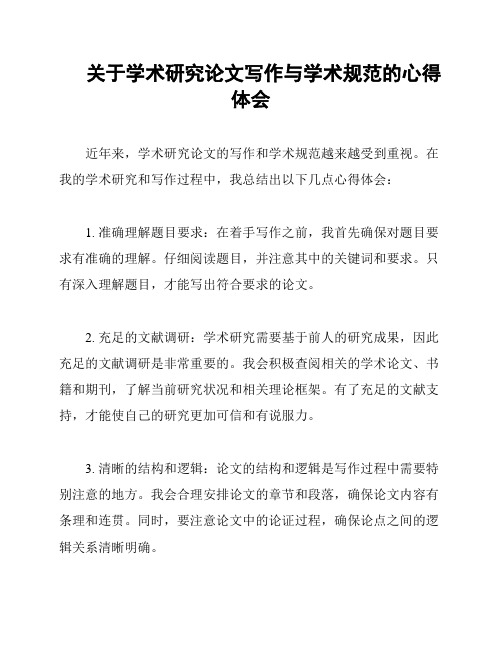
关于学术研究论文写作与学术规范的心得体会近年来,学术研究论文的写作和学术规范越来越受到重视。
在我的学术研究和写作过程中,我总结出以下几点心得体会:1. 准确理解题目要求:在着手写作之前,我首先确保对题目要求有准确的理解。
仔细阅读题目,并注意其中的关键词和要求。
只有深入理解题目,才能写出符合要求的论文。
2. 充足的文献调研:学术研究需要基于前人的研究成果,因此充足的文献调研是非常重要的。
我会积极查阅相关的学术论文、书籍和期刊,了解当前研究状况和相关理论框架。
有了充足的文献支持,才能使自己的研究更加可信和有说服力。
3. 清晰的结构和逻辑:论文的结构和逻辑是写作过程中需要特别注意的地方。
我会合理安排论文的章节和段落,确保论文内容有条理和连贯。
同时,要注意论文中的论证过程,确保论点之间的逻辑关系清晰明确。
4. 准确引用和注释:学术研究中,对于他人的观点和成果,必须准确引用和注释。
我会遵循学术规范,在论文中使用恰当的引用方式,并给出相关的注释。
正确引用可以显示研究的深度和广度,也可以避免抄袭和剽窃的问题。
5. 语言表达和文字规范:在论文写作中,准确、简洁的语言表达是非常重要的。
我会尽量使用准确的词汇和专业术语,使自己的观点更加清晰明了。
同时,注意文字的规范和准确性,避免拼写错误和语法问题。
通过以上的心得体会,我认为在学术研究论文写作中,准确理解题目、充足的文献调研、清晰的结构和逻辑、准确引用和注释以及语言表达和文字规范是至关重要的。
只有在严格遵守学术规范的前提下,才能产出高质量的学术论文并为学术研究作出贡献。
以上是我对学术研究论文写作与学术规范的心得体会,希望能对您的学术研究有所帮助。
学术论文写作与发表

学术论文写作的基本要素
1 确定研究问题
一个明确的研究问题是论文写作的第一步。
2 查找和评估文献
综合并评估相关文献,找到适合自己研究的材料。,使读者能够轻松理解研究内容。
学术论文发表的步骤
1
准备论文摘要
编写简明扼要的摘要,吸引读者进一步了解论文内容。
2
选择合适的期刊或会议
学术论文写作与发表
学术论文写作与发表是学术界中的关键环节,它有助于学术声誉的提升,为 研究做出贡献,并推动学科的进展。
学术论文写作与发表的重要性
学术声誉提升
优秀的学术论文能够提高学者的声誉和知名度。
为研究做出贡献
发表论文使研究成果为他人所了解和应用。
推动学科前进
论文发表不仅促进自身学科的进步,还为其他研究者提供了借鉴和启发。
根据研究领域选择出版论文的合适期刊或会议。
3
在论文中展示研究结果
清晰地呈现研究结果,使用图表等可视化工具。
4
通过同行评审获得反馈
接受同行专家的审稿意见,并进行必要的修改和改进。
发表学术论文的挑战
编写清晰和简洁的语言
使用准确流畅的语言表达科学观点是最大的挑战之一。
写作文和写学术论文的区别
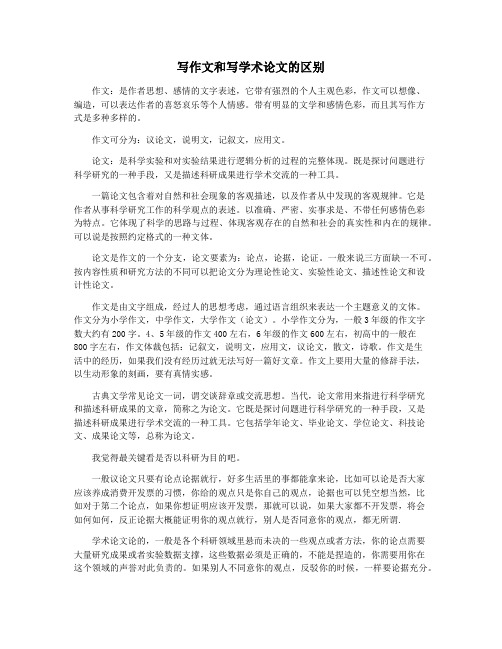
写作文和写学术论文的区别作文:是作者思想、感情的文字表述,它带有强烈的个人主观色彩,作文可以想像、编造,可以表达作者的喜怒哀乐等个人情感。
带有明显的文学和感情色彩,而且其写作方式是多种多样的。
作文可分为:议论文,说明文,记叙文,应用文。
论文:是科学实验和对实验结果进行逻辑分析的过程的完整体现。
既是探讨问题进行科学研究的一种手段,又是描述科研成果进行学术交流的一种工具。
一篇论文包含着对自然和社会现象的客观描述,以及作者从中发现的客观规律。
它是作者从事科学研究工作的科学观点的表述。
以准确、严密、实事求是、不带任何感情色彩为特点。
它体现了科学的思路与过程、体现客观存在的自然和社会的真实性和内在的规律。
可以说是按照约定格式的一种文体。
论文是作文的一个分支,论文要素为:论点,论据,论证。
一般来说三方面缺一不可。
按内容性质和研究方法的不同可以把论文分为理论性论文、实验性论文、描述性论文和设计性论文。
作文是由文字组成,经过人的思想考虑,通过语言组织来表达一个主题意义的文体。
作文分为小学作文,中学作文,大学作文(论文)。
小学作文分为,一般3年级的作文字数大约有200字。
4、5年级的作文400左右,6年级的作文600左右,初高中的一般在800字左右,作文体裁包括:记叙文,说明文,应用文,议论文,散文,诗歌。
作文是生活中的经历,如果我们没有经历过就无法写好一篇好文章。
作文上要用大量的修辞手法,以生动形象的刻画,要有真情实感。
古典文学常见论文一词,谓交谈辞章或交流思想。
当代,论文常用来指进行科学研究和描述科研成果的文章,简称之为论文。
它既是探讨问题进行科学研究的一种手段,又是描述科研成果进行学术交流的一种工具。
它包括学年论文、毕业论文、学位论文、科技论文、成果论文等,总称为论文。
我觉得最关键看是否以科研为目的吧。
一般议论文只要有论点论据就行,好多生活里的事都能拿来论,比如可以论是否大家应该养成消费开发票的习惯,你给的观点只是你自己的观点,论据也可以凭空想当然,比如对于第二个论点,如果你想证明应该开发票,那就可以说,如果大家都不开发票,将会如何如何,反正论据大概能证明你的观点就行,别人是否同意你的观点,都无所谓.学术论文论的,一般是各个科研领域里悬而未决的一些观点或者方法,你的论点需要大量研究成果或者实验数据支撑,这些数据必须是正确的,不能是捏造的,你需要用你在这个领域的声誉对此负责的。
学术论文的写作要求及写作方法

学术论文的写作要求及写作方法
一、学术论文写作要求
1、框架完整:开头说明话题背景、把握研究焦点、说明研究目的、简述理论基础;正文展开研究内容、描述研究方法、处理分析数据;结尾概括研究结果、说明其含义、指出研究不足及今后可延伸的研究方向。
3、思路清晰:文章内容要求条理清楚、逻辑严密,文字连贯,每段落的开头要有明确的思路指引。
二、学术论文写作方法
1、对于学术论文的写作,首先应该选定一个课题,并着重钻研。
2、深入研究,搜集有效的资料,熟悉论文的结构框架,把握写作的步骤。
3、根据研究课题分析,明确研究的目的、理论基础,再明确研究思路,安排事项,详细撰写学术论文的正文部分。
4、做好文献检索,收集有用文献,对于这些文献,要明确论文与文献的关联,就要认真研读,对文献中出现的观点进行总结、梳理、分析、归纳。
学术论文范文16篇优秀版
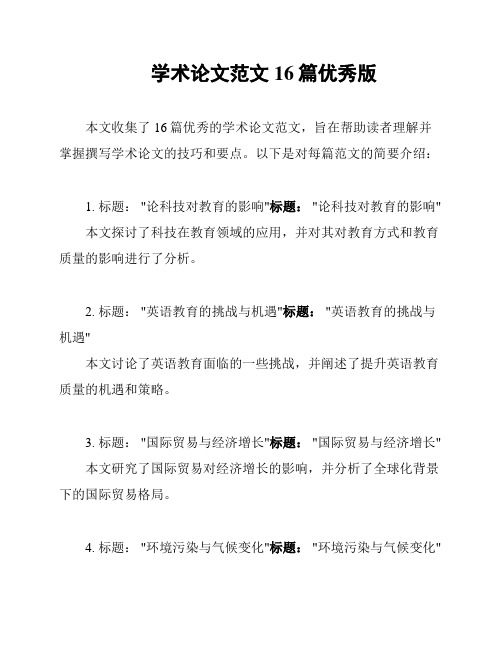
学术论文范文16篇优秀版本文收集了16篇优秀的学术论文范文,旨在帮助读者理解并掌握撰写学术论文的技巧和要点。
以下是对每篇范文的简要介绍:1. 标题: "论科技对教育的影响"标题: "论科技对教育的影响"本文探讨了科技在教育领域的应用,并对其对教育方式和教育质量的影响进行了分析。
2. 标题: "英语教育的挑战与机遇"标题: "英语教育的挑战与机遇"本文讨论了英语教育面临的一些挑战,并阐述了提升英语教育质量的机遇和策略。
3. 标题: "国际贸易与经济增长"标题: "国际贸易与经济增长"本文研究了国际贸易对经济增长的影响,并分析了全球化背景下的国际贸易格局。
4. 标题: "环境污染与气候变化"标题: "环境污染与气候变化"本文探讨了环境污染与气候变化之间的关系,同时探索了减缓气候变化所需的政策和行动。
5. 标题: "人工智能在医疗领域的应用"标题: "人工智能在医疗领域的应用"本文介绍了人工智能在医疗领域的应用情况,并探讨了其带来的机遇和挑战。
6. 标题: "城市化与社会问题"标题: "城市化与社会问题"本文研究了城市化过程中出现的影响社会问题,并提出了改善城市化进程的建议。
7. 标题: "金融危机的影响与教训"标题: "金融危机的影响与教训"本文分析了过去金融危机对经济的影响,并总结了从中所得到的教训。
8. 标题: "全球健康挑战与应对策略"标题: "全球健康挑战与应对策略"本文探讨了全球范围内面临的健康挑战,并提出了应对这些挑战的策略和方法。
9. 标题: "社交媒体对年轻人的影响"标题: "社交媒体对年轻人的影响"本文研究了社交媒体对年轻人的影响,并讨论了如何合理利用社交媒体的方法。
如何进行学术论文写作

如何进行学术论文写作学术论文写作是大学生在学术领域中必须掌握的重要技能之一、下面是一些建议,帮助你进行学术论文写作。
1.主题选择:选择一个适合你领域的研究主题。
确保你对此主题有足够的兴趣和知识。
2.阅读文献:在开始写作前,仔细阅读相关领域的学术文献。
这将帮助你了解当前研究的现状和前沿。
3.制定大纲:在开始写作之前,制定一个清晰的大纲。
大纲将帮助你组织思路并确保论文结构合理。
按照引言、方法、结果、讨论和结论的顺序进行组织。
4.写作风格:学术论文的写作风格应该是客观、明确和简洁的。
使用清晰的句子结构和专业术语。
避免使用口语化的表达和不必要的修辞。
5.引言:在引言部分,说明你的研究背景和目的。
提出你的研究问题并解释其重要性。
6.方法:详细描述你的研究方法,以便其他人可以复制你的实验或调查。
确保描述清晰且准确。
7.结果:在结果部分,提供你的研究结果的详细信息。
使用表格、图表和统计数据来支持你的结果。
8.讨论:在讨论部分,解释你的结果,并与已有的研究进行比较和对比。
分析你的结果并提出你的观点。
9.结论:在结论部分,总结你的研究结果,并强调其重要性及对该领域的贡献。
提出你的研究的局限性,并提出进一步的研究建议。
10.引用文献:在学术论文中,引用其他学者的工作是必要的。
确保使用适当的引用格式,如APA、MLA等。
12.合作与反馈:如果可能,与同行进行合作写作,并接受他们的反馈意见。
这将有助于改善你的论文质量。
总的来说,学术论文写作需要耐心和细心。
遵循以上建议,你将能够编写出具备学术价值的论文。
学术论文写作与研究方法

学术论文写作与研究方法学术论文写作和研究方法是每一位学术工作者必备的技能。
无论是对于学生,还是对于教师或研究人员来说,掌握正确的学术论文写作方法和科学的研究方法都是至关重要的。
本文将着重介绍学术论文写作的基本结构和研究方法的选择与应用。
一、学术论文写作学术论文写作是一种系统性的科学写作,准确无误地呈现研究成果和思想观点。
下面将介绍学术论文常用的结构和写作技巧。
一、引言学术论文的引言部分是论文的开端,需要引起读者的兴趣,并介绍研究背景、研究目的和价值。
同时,引言部分还需要提出问题并对前人研究成果进行评价和批判。
二、文献综述在学术论文中,文献综述是非常重要的一部分。
通过对相关研究的综述,可以准确理解目前研究的现状,找出研究的空白点并为自己的研究提供理论支持。
三、方法学术论文的方法部分需要详细描述研究方法的选择和应用。
具体包括:研究设计、样本选取、数据收集和分析方法等。
这一部分需要准确、详尽地描述实验过程和方法的合理性。
四、结果在学术论文中,结果部分是对研究数据的客观呈现,可以采用文字、表格、图表等形式进行展示。
同时,应该对结果进行合理的解释和分析,并与前人研究进行对比。
五、讨论讨论部分是对研究结果的深入分析和解释,需要回答研究问题和验证假设。
同时,还可以探讨研究结果的局限性、产生的原因以及对未来研究的启示。
六、结论学术论文的结论部分需要对整个研究过程进行总结,并提出进一步研究的建议。
同时,结论部分还可以强调研究的贡献和意义。
二、研究方法的选择与应用研究方法的选择与应用是决定学术论文质量的关键因素之一。
下面将介绍几种常用的研究方法及其适用性。
一、实证研究方法实证研究方法是一种基于观察和实证分析的方法。
在实证研究中,研究者通过实证数据的收集和分析,来验证研究假设或回答研究问题。
实证研究方法适用于对现象进行客观观察和定量分析的研究。
二、理论研究方法理论研究方法是一种基于理论分析和比较的方法。
在理论研究中,研究者通过对文献的梳理和理论框架的构建,来解决或理解研究问题。
学术论文和文学写作的区别
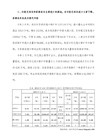
来源:网络 作者:580202论文查重
知网论文检测
近年来,对于论文写作,无论是高校还是学术机构、或者一些期刊、出版社,都热衷于使用知网论文检测系统。这在放学术不端的问题上起到了极大的作用。
对于学术论文的写作要求,仍然让许多人迷惑。学术论文不能和文学类的写作相混淆。这也是为什么说“文笔好”未必就能写得出好论文的原因。还有就是,即使通过了论文检测,也未必能够被知名期刊选上并发表。这是由论文的内容决定的。
ቤተ መጻሕፍቲ ባይዱ
总之,务必区分学术论文写作和文学写作的不同。如果把一篇学术论文写成了一篇文学作品,就会显得不伦不类,缺乏学术的严谨性,也缺乏说服力。学术论文写作是基于学术研究的书面陈述,并带有创新性和探索性,遵循相对固定的格式,撰写者必须严谨对待,并通过580202知网论文检测,以探索真理为导向。
其次,论文写作语言风格具有鲜明的特点,即用语严谨。论文写作虽然并不排斥使用一些比较活泼的、富有文采的语言,但是论文写作往往比较忌讳对事实描述进行夸张或者过度渲染,只要能“实事求是”,用朴实的语言陈述出来即可。而对于文学写作而言,夸张、场景渲染,都可以增加文章语言的表达效果。
最后一点是,论文的格式要求比较固定,论文从开题到结束,都遵守既有的论文写作规范。对于标题、引用等更是做了极其严格的要求。论文结构完整,切忌使用片段式的表达,而文学写作则不拘于此,文学写作并没有固定的格式,作者可以随意行文。当然,有一定的文体类别,像诗歌、散文等。各个要求都和论文写作大大不同。
那么,论文写作和文学写作有什么区别呢?
首先,论文写作和新闻写作一样,最重要的一点就是真实性。论文写作,探究和讨论的都是学术问题。也是因此,论文写作往往需要通过搜集很多资料、通过许多调查和研究活动,直接获得真实的检验结果,才会具备说服力,论文在通过知网论文检测的前提下,体现其学术研究价值。而文学写作则可以虚构,也可以纪实,只要能表达出作者所想要表达的思想感情、不违背基本法律和道德伦理,即可为人们所接受。
学术论文写作指导
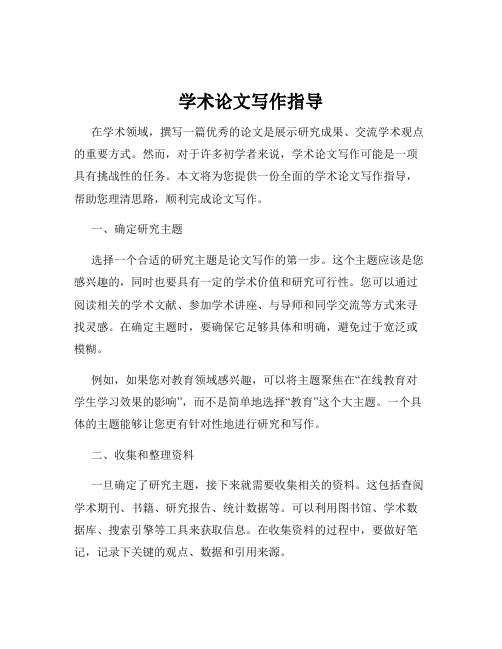
学术论文写作指导在学术领域,撰写一篇优秀的论文是展示研究成果、交流学术观点的重要方式。
然而,对于许多初学者来说,学术论文写作可能是一项具有挑战性的任务。
本文将为您提供一份全面的学术论文写作指导,帮助您理清思路,顺利完成论文写作。
一、确定研究主题选择一个合适的研究主题是论文写作的第一步。
这个主题应该是您感兴趣的,同时也要具有一定的学术价值和研究可行性。
您可以通过阅读相关的学术文献、参加学术讲座、与导师和同学交流等方式来寻找灵感。
在确定主题时,要确保它足够具体和明确,避免过于宽泛或模糊。
例如,如果您对教育领域感兴趣,可以将主题聚焦在“在线教育对学生学习效果的影响”,而不是简单地选择“教育”这个大主题。
一个具体的主题能够让您更有针对性地进行研究和写作。
二、收集和整理资料一旦确定了研究主题,接下来就需要收集相关的资料。
这包括查阅学术期刊、书籍、研究报告、统计数据等。
可以利用图书馆、学术数据库、搜索引擎等工具来获取信息。
在收集资料的过程中,要做好笔记,记录下关键的观点、数据和引用来源。
同时,要对收集到的资料进行整理和分析,筛选出有用的信息,并对其进行分类和归纳。
这有助于您在写作过程中更好地组织和引用资料。
三、拟定论文提纲在正式写作之前,先拟定一个详细的论文提纲是非常有帮助的。
提纲可以帮助您构建论文的框架,明确各个部分的内容和逻辑关系。
一般来说,学术论文包括引言、文献综述、研究方法、研究结果、讨论与分析、结论等部分。
在提纲中,要对每个部分的主要内容进行简要描述,列出主要的论点和论据。
例如,引言部分要介绍研究的背景和意义;文献综述要对前人的研究进行总结和评价;研究方法要说明您采用的研究设计、数据收集和分析方法;研究结果要呈现您的研究发现;讨论与分析要对结果进行解释和讨论,并与前人的研究进行比较;结论部分要总结研究的主要成果和贡献,并提出未来的研究方向。
四、撰写引言引言是论文的开头部分,其主要目的是吸引读者的兴趣,引出研究问题,并阐述研究的意义和价值。
论文和作文的区别

论文和作文的区别论文和作文是学术写作中两种常见的形式。
虽然它们都是书面表达的方式,但在格式、目的、内容和写作风格等方面有明显的区别。
首先,论文是一种系统的学术写作形式,其主要目的是通过研究、分析和讨论特定的主题或问题来建立和发展知识。
论文通常由导师或教授指导,基于对特定领域的深入研究和学术理论的运用来撰写。
论文的结构一般包括引言、文献综述、研究方法、结果和讨论等部分。
论文需要进行深入的研究和数据分析,并提出新的观点或结论。
在学术界,论文通常被用于推进学科的发展和交流学术成果。
相比之下,作文更加自由,强调个人观点和创造性思维。
作文可以是记叙文、说明文、议论文等不同类型,通过人们对社会、文化、个人经验等方面的思考来表达个人观点和情感。
作文主要关注于自我表达和感知,通过语言的艺术和修辞手法来吸引读者。
作文的结构更加灵活,可以根据作者的意图和主题进行调整。
作文通常用于教育领域,培养学生的写作能力和创造性思维。
此外,论文和作文在内容上也有所区别。
论文着重于专业领域的研究和理论,需要对相关学术文献进行综述和引用。
论文通常要求提供实验证据和数据分析,并遵循学术规范和引用格式。
而作文则更注重个人观点和自由思维,可以涉及任何主题,包括个人经历、社会问题、文化现象等。
最后,论文和作文在写作风格上也有所不同。
论文要求客观、准确和严谨,使用学术语言和专业术语。
论文需要遵循学术规范,注重逻辑清晰和论证力度。
而作文则更灵活,允许使用较为生动、形象的语言和修辞手法,以吸引读者的注意力。
总之,论文和作文在格式、目的、内容和写作风格等方面存在明显的区别。
论文更加系统和专业,注重研究和理论运用;作文更加自由和创造性,注重个人观点和情感表达。
无论是论文还是作文,都是有效的表达思想和观点的方式,在不同的场合有着不同的应用价值。
学术论文的写作和投稿
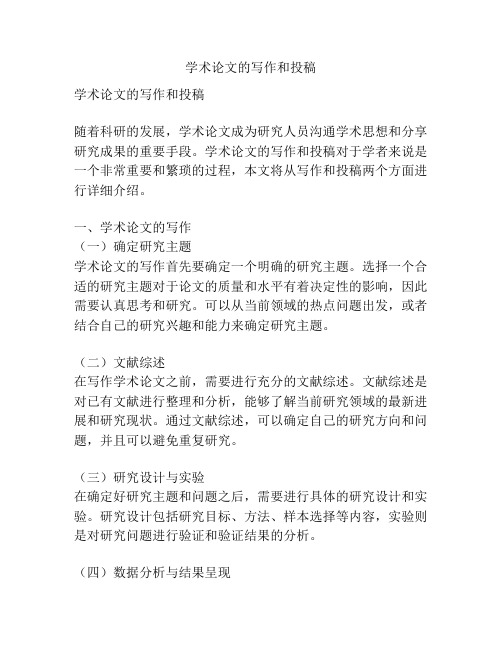
学术论文的写作和投稿学术论文的写作和投稿随着科研的发展,学术论文成为研究人员沟通学术思想和分享研究成果的重要手段。
学术论文的写作和投稿对于学者来说是一个非常重要和繁琐的过程,本文将从写作和投稿两个方面进行详细介绍。
一、学术论文的写作(一)确定研究主题学术论文的写作首先要确定一个明确的研究主题。
选择一个合适的研究主题对于论文的质量和水平有着决定性的影响,因此需要认真思考和研究。
可以从当前领域的热点问题出发,或者结合自己的研究兴趣和能力来确定研究主题。
(二)文献综述在写作学术论文之前,需要进行充分的文献综述。
文献综述是对已有文献进行整理和分析,能够了解当前研究领域的最新进展和研究现状。
通过文献综述,可以确定自己的研究方向和问题,并且可以避免重复研究。
(三)研究设计与实验在确定好研究主题和问题之后,需要进行具体的研究设计和实验。
研究设计包括研究目标、方法、样本选择等内容,实验则是对研究问题进行验证和验证结果的分析。
(四)数据分析与结果呈现在完成实验后,需要对实验数据进行统计和分析,得出科学的结论。
根据实验结果,可以采用图表、表格等方式将结果呈现出来,使读者更加清晰地理解研究成果。
(五)撰写论文在完成数据分析和结果呈现之后,可以开始撰写论文。
学术论文的撰写需要遵循规范的结构和格式,一般包括摘要、引言、研究方法、结果和讨论、结论等部分。
在撰写过程中,需要注意语言清晰、逻辑严密、数据准确等方面的要求。
二、学术论文的投稿(一)选择期刊完成论文的撰写后,需要选择一个合适的学术期刊进行投稿。
选择期刊时可以考虑与研究主题、研究水平和期刊影响因子相匹配的期刊。
在选择期刊时,还需要考虑期刊的官方网站、投稿指南和主编等相关信息,以便更好地了解投稿要求。
(二)审查修改在选择好期刊后,需要将论文提交给期刊编辑部进行审查和修改。
审查过程一般分为两个环节:一是编辑部的初审,主要是查看论文是否符合期刊的范围和要求;二是同行评审,即由专家学者对论文的质量、学术价值等进行评审。
学术论文的写作
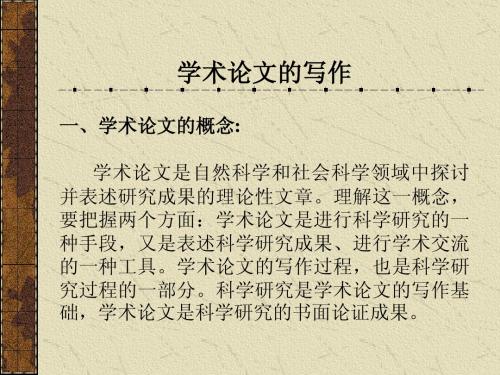
(五)拟写提纲:提纲的写法有两种:一种是标 题式写法;一种是提要式写法。例如: 题目 基本论点 内容纲要 一、 大项目(上位论点,大段段旨) (一)中项目(下位论点,段旨) 1.小项目(一个个材料) …… (六)写好论文各部分:学术论文通常包括标题 、署名、目录、摘要、关键词、正文(引论、本论、 结论)、注释、致谢、参考文献、附录等部分。
三、学术论文的写作要求:
(一)选择论题: 选择论题就是确定一篇学术论文的研究方向 和研究对象。它是学术论文写作的第一步。 选择论题遵循的原则: 1、选择有研究价值的论题。 (1)亟待解决的问题; (2)科学上的新发现; (3)空白的添补; (4)通说的纠正; (5)前说的补充。
2、要选择有研究条件的论题。 客观条件:(1)要考虑资料条件 (2)要考虑时间条件 (3)要考虑导师的指导条件 主观条件: ( 1 )要选择能发挥自己业务专长的论文( 扬长避短) (2)要选择自己最感兴趣的论题 (3)要充分估计自己的能力(大小适中)
(二)搜集材料 撰写学术论文,一般要搜集两类材料:一类是研 究对象的原始材料,一类是他人的有关研究对象的论 述。没有材料,科学研究便无从着手,理论观点便无 法形成。 搜集材料,主要有三个途径:利用图书馆;实地 调查;观察和实验。 (三)确立论点 中心论点在搜集材料并进行分析研究的过程中逐 渐形成。确立论点的科学方法主要有逻辑分析法和统 计分析法。 (四)选定论据 学术论文的论据就是论点确立的根据。证明论点 的事实或道理就是论据。要继续深入地研究材料;要 认识材料的从属关系;要确立主要材料和次要材料。
二、学术论文的写作特点:
1、学术性 所谓学术是指较为专门的有系统的学问。学术论文是学 术成果的载体,它的内容是作者在某一科学领域中潜心研究 并有所发现的结果,具有系统性和专门性,不同于一般的心 得体会。学术论文的学术性表现在:具有一定的理论高度; 具有指导实践的学术价值;具有新颖独到的见解。 2、理论性 所谓理论就是人们由实践概括出来的关于自然界和社会 知识的系统结论。学术论文的理论性表现在:首先内容的深 度上,反映的内容不是一般现象和过程,也不是浅显的经验 法则,而是作者对事物本质和规律的深刻认识;其次,表现 在文章的整体构成上,理论的构成是一种逻辑构成,观点材 料以及能把两者统一起来的逻辑框架缺一不可。
学术论文写作要点

学术论文写作要点学术论文是在学术界发表研究成果、交流学术观点的主要方式之一。
一篇优秀的学术论文应该具备严谨的逻辑思维、清晰的表达方式和准确的数据分析。
本文将介绍学术论文写作的几个重要要点,包括选题、文献综述、研究方法、结果展示和讨论等内容。
一、选题选题是学术论文写作的第一步,一个合适的选题能够使研究有一定的学术意义和实际应用价值。
在选题时,需要充分了解已有的研究成果和最新的研究进展,找到研究空白和问题,并提出自己的研究目标和假设。
二、文献综述文献综述是在论文中对前人研究成果的回顾和总结。
通过文献综述,可以展示自己对该领域的掌握程度,并定位自己的研究问题。
在写文献综述时,应该选择有代表性的文献,并按照时间顺序或主题分类进行组织,注意不要陷入简单的摘抄或者简单罗列,要注意结构清晰、观点明确。
三、研究方法研究方法是学术论文的核心部分,是对研究问题进行验证和实证的手段。
在选择研究方法时,需要根据研究目标和问题确定适当的研究设计和数据收集方法,并对数据进行统计分析。
在论文中,需要详细描述研究方法,使读者清楚地了解研究的过程和操作。
四、结果展示结果展示是将数据和实证分析结果以图表或文本形式呈现给读者。
在展示结果时,应该选择最具代表性和关键性的数据,并用清晰的语言进行描述。
如果有必要,可以使用统计方法进行结果的验证和解释。
此外,还可以通过比较、归纳等手段对结果进行进一步讨论和分析。
五、讨论讨论是学术论文的重要组成部分,可以对结果进行解释、对假设进行验证,并进一步拓展和深化问题。
在讨论中,需要对实验结果的优点和不足、研究方法的优势和局限性进行客观评价,并提出自己的观点和建议。
此外,还可以与前人的研究成果进行对比和探讨,展示研究的创新点和贡献。
六、结论结论是学术论文的总结和回顾,对研究目标和假设进行验证和总结。
在写结论时,应该简明扼要地概括研究的主要发现和结论,并指出进一步研究的方向和价值。
综上所述,学术论文写作是一项细致耐心的工作,需要合理的结构安排、准确的表达和严谨的逻辑推理。
学术论文写作与发表流程

学术论文写作与发表流程学术论文是科研工作者分享研究成果的重要方式之一。
本文将为您介绍学术论文的写作与发表流程,帮助您更好地了解并掌握这一过程。
一、选题与研究方法在写作学术论文之前,我们首先需要确定一个合适的研究题目。
选题应具备一定的研究价值和创新性,并且与当前学术领域的热点问题相关。
接下来,我们需要明确所采用的研究方法,例如实证研究、文献综述、案例分析等。
选题和研究方法的确定对于后续的写作非常重要,应该认真思考和论证。
二、文献综述与论文结构在论文写作之前,我们应该进行相关领域的文献综述,了解已有研究的进展和不足之处,并从中找到研究的切入点。
论文结构应该包括引言、文献综述、研究方法、实证分析、结果与讨论以及结论等部分。
每个部分的内容应该紧密联系,条理清晰,逻辑严密。
三、数据采集与分析如果我们的研究需要采集实证数据,我们需要选择合适的方法进行数据采集,例如问卷调查、深度访谈、实验设计等。
采集到的数据需要进行系统整理和分析,以验证我们的研究假设或回答研究问题。
数据分析可以使用统计软件进行,比如SPSS、Excel等。
四、撰写论文在撰写论文的过程中,我们需要注意语言的准确性和书写的规范。
论文应该清晰地表达研究目的、方法和结果,使用术语应当准确。
同时,注意论文的格式要求,包括字数限制、页边距、参考文献格式等。
在写作过程中,可以重复修改和润色,确保论文的质量。
五、审稿与修改完成论文后,我们需要将其投稿到相关的学术期刊。
期刊编辑将会组织同行专家进行审稿,对论文的质量和学术价值进行评估。
审稿意见通常包括接受、修改或拒绝。
根据审稿意见,我们需要认真修改论文,并对修改进行回复。
修改后的论文提交给期刊编辑进行最终审查。
六、论文发表与传播如果论文通过审稿并最终被接受,学术期刊将会安排其发表,并在公开领域进行传播。
学术会议也是分享研究成果的重要平台,可以选择在会议上进行口头报告或海报展示。
此外,我们可以将论文上传至学术社交平台或者个人网站,与他人分享并扩大影响力。
学术论文范文4篇
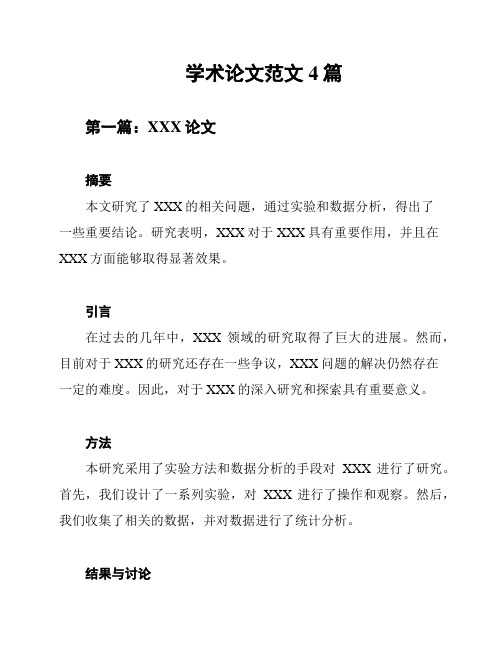
学术论文范文4篇第一篇:XXX论文摘要本文研究了XXX的相关问题,通过实验和数据分析,得出了一些重要结论。
研究表明,XXX对于XXX具有重要作用,并且在XXX方面能够取得显著效果。
引言在过去的几年中,XXX领域的研究取得了巨大的进展。
然而,目前对于XXX的研究还存在一些争议,XXX问题的解决仍然存在一定的难度。
因此,对于XXX的深入研究和探索具有重要意义。
方法本研究采用了实验方法和数据分析的手段对XXX进行了研究。
首先,我们设计了一系列实验,对XXX进行了操作和观察。
然后,我们收集了相关的数据,并对数据进行了统计分析。
结果与讨论通过实验和数据分析,我们得到了如下的结论:XXX对于XXX具有重要作用,能够显著提高XXX的效果。
这一结果与之前的研究相符合,并且为进一步的研究提供了重要的理论依据。
结论本文通过实验研究和数据分析,证明了XXX对于XXX的重要性,并且在XXX方面能够取得显著效果。
这一研究不仅为XXX领域的理论研究提供了新的思路,也为实际应用中的XXX问题的解决提供了有力支持。
第二篇:YYY论文摘要本文研究了YYY的相关问题,通过理论分析和模拟实验,得出了一些关键结论。
研究表明,YYY在YYY方面具有重要意义,并且能够在YYY方面取得显著效果。
......(根据需要写出另外两篇论文的摘要,引言,方法,结果与讨论,结论)...总结通过对于这四篇学术论文范文的介绍,我们可以看到学术论文的一般结构是相似的,包括摘要、引言、方法、结果与讨论以及结论。
每篇论文都需要明确问题的研究背景和目的,清晰陈述研究方法和实验设计,准确分析数据并得出结论。
这些范文可以为我们写作学术论文提供参考和借鉴,帮助我们更好地进行论文写作。
希望以上内容符合您的要求。
如有其他需要,请随时告诉我。
学生学术科研与论文写作指导

学生学术科研与论文写作指导一、爱上科研与论文写作随着社会的发展,学术科研与论文写作已经成为当今学生学习过程中的重要组成部分。
我们应该培养自己对科研工作的热爱和兴趣。
爱上科研与论文写作,不仅能够提升个人的学术能力,还有助于拓宽视野、培养责任感。
二、选择合适的研究题目选择一个合适的研究题目是论文写作的首要任务。
首先,我们需要选择自己感兴趣的领域,这样才能在科研过程中保持激情。
其次,我们应该选择一个有研究价值和创新性的题目,这样才能产生积极的科研成果。
三、明确研究目的和问题在进行研究前,我们需要明确研究目的和问题。
研究目的是为了解决某个具体问题,而研究问题则是对研究目的的具体化和细化。
明确研究目的和问题有助于我们在研究过程中保持方向性和针对性。
四、合理规划研究方法和步骤在进行学术科研时,我们需要合理规划研究方法和步骤。
研究方法是指我们在研究中所采用的科学方法和手段,而步骤则是研究的整体流程和时间安排。
合理规划研究方法和步骤有助于我们高效地完成研究任务。
五、深入文献综述在进行学术科研时,充分了解前人的研究成果是非常重要的。
深入文献综述,不仅可以了解当前领域的研究进展,还可以寻找到研究的空白和问题。
通过阅读已有文献,我们可以更好地进行研究设计和方法选择。
六、数据采集与分析在科研过程中,数据采集和分析是至关重要的一步。
我们需要根据具体的研究方法和问题,采集相关的数据,并对数据进行合理的统计和分析。
通过数据的采集与分析,我们可以验证研究假设,并对研究问题进行解答。
七、合理撰写论文结构在进行论文写作时,我们需要合理撰写论文结构。
论文结构一般包括引言、文献综述、方法、结果与讨论、结论等部分。
每一部分的内容需要紧密联系,并按照逻辑顺序进行阐述。
合理的论文结构有助于读者更好地理解和接受我们的研究成果。
八、精心书写引言和结论引言和结论是论文中的重要组成部分,需要我们精心书写。
引言应该准确地阐述研究背景和意义,并提出研究目的和问题。
学术研究与论文写作
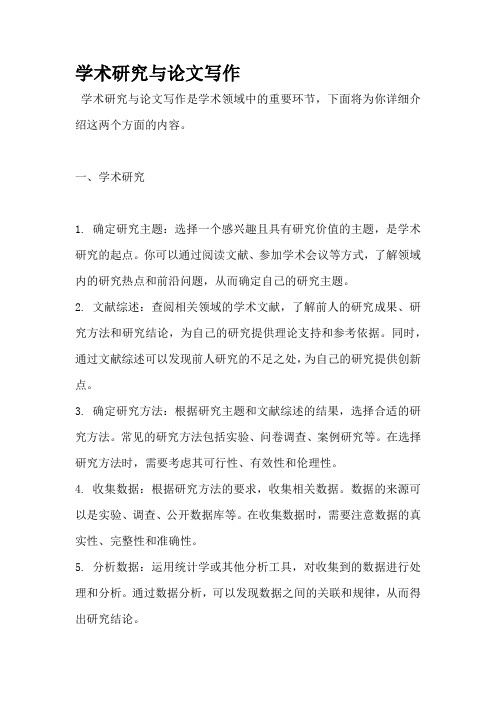
学术研究与论文写作学术研究与论文写作是学术领域中的重要环节,下面将为你详细介绍这两个方面的内容。
一、学术研究1. 确定研究主题:选择一个感兴趣且具有研究价值的主题,是学术研究的起点。
你可以通过阅读文献、参加学术会议等方式,了解领域内的研究热点和前沿问题,从而确定自己的研究主题。
2. 文献综述:查阅相关领域的学术文献,了解前人的研究成果、研究方法和研究结论,为自己的研究提供理论支持和参考依据。
同时,通过文献综述可以发现前人研究的不足之处,为自己的研究提供创新点。
3. 确定研究方法:根据研究主题和文献综述的结果,选择合适的研究方法。
常见的研究方法包括实验、问卷调查、案例研究等。
在选择研究方法时,需要考虑其可行性、有效性和伦理性。
4. 收集数据:根据研究方法的要求,收集相关数据。
数据的来源可以是实验、调查、公开数据库等。
在收集数据时,需要注意数据的真实性、完整性和准确性。
5. 分析数据:运用统计学或其他分析工具,对收集到的数据进行处理和分析。
通过数据分析,可以发现数据之间的关联和规律,从而得出研究结论。
6. 撰写研究报告:将研究过程、方法和结果整理成研究报告。
研究报告需要包括摘要、引言、文献综述、研究方法、数据分析、结论等部分。
在撰写研究报告时,需要注意语言准确、逻辑清晰、图表规范。
二、论文写作1. 确定论文类型:根据研究领域和目的,选择合适的论文类型。
常见的论文类型包括学术论文、期刊论文、会议论文等。
不同类型的论文有不同的写作规范和要求。
2. 撰写论文提纲:在撰写论文之前,需要先制定一个详细的提纲。
提纲可以帮助你理清思路,明确论文的结构和内容。
提纲应包括标题、摘要、引言、正文(包括理论阐述和实证研究)、结论等部分。
3. 撰写正文:根据提纲的要求,开始撰写正文部分。
在撰写正文时,需要注意语言准确、表达清晰、逻辑严密。
同时,还需要注意引用前人研究成果和遵守学术规范。
4. 制作图表:根据论文的需要,制作相应的图表来辅助说明和解释数据或理论模型。
学术论文的定义特点写作方法以及写作格式

学术论文的定义特点写作方法以及写作格式学术论文是学术研究成果的一种书面表达形式,主要用于传播新知识、展示研究成果、推动学术进展。
下面将分别介绍学术论文的定义、特点、写作方法以及写作格式。
一、学术论文的定义学术论文是指学者或研究者根据一定的研究方法和科学原则,对特定的问题进行调查、研究和探讨,通过书面形式进行表达和展示的一种学术成果。
它具有系统性、科学性、创新性、可验证性等特征。
二、学术论文的特点1.系统性:学术论文需要包含引言、文献综述、研究方法、实验设计、结果分析和结论等内容,形成一个有机结构。
2.科学性:学术论文要以科学的方法进行研究,采用严密的逻辑、可靠的数据和可重复的实验来支持论点。
3.创新性:学术论文要求具有新的研究观点、新的实验设计或新的研究结果,对该领域的进展具有推动作用。
4.可验证性:学术论文的观点、结论和结果应基于可获得的实证证据,并通过实验证明其正确性。
5.学术性:学术论文需要具备学术语言和学术规范,引用他人的研究成果并注明出处,确保学术交流的公正性和透明度。
三、学术论文的写作方法1.确定研究问题:选择一个有研究价值和实际意义的问题,明确研究目的和研究对象。
2.进行文献综述:查阅相关文献,了解研究现状和前沿,分析和归纳已有研究成果。
3.设计研究方法:根据研究问题和目的,选择合适的研究方法和数据收集方法,设计实验或调查方案。
4.收集和分析数据:按照设计方案进行数据收集,使用统计方法和适当的工具对数据进行分析和解释。
5.撰写论文各部分:按照引言、文献综述、研究方法、实验设计、结果分析和结论等部分的顺序,逐一完成论文的写作。
四、学术论文的写作格式1.封面:包括论文题目、作者姓名、学校或机构名称、日期等信息。
2.摘要:简要概括研究背景、目的、方法、结果和结论等内容,不超过300字。
3.引言:介绍研究问题的背景和意义,明确研究目的和研究对象。
4.文献综述:总结前人的研究成果和观点,提出研究的动机和创新点。
学术论文各部分的写作要求与方法
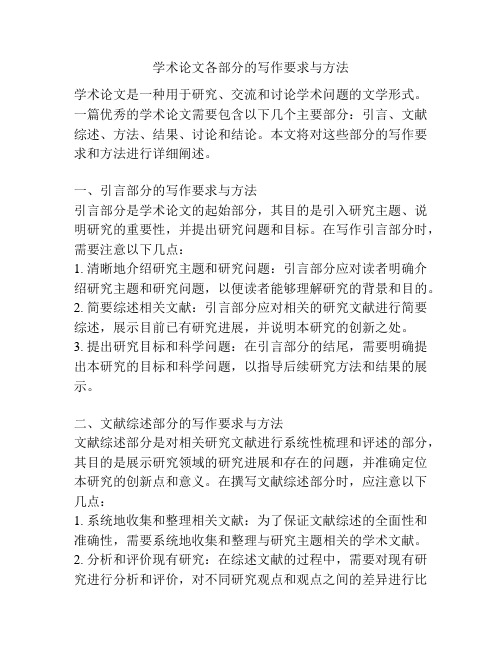
学术论文各部分的写作要求与方法学术论文是一种用于研究、交流和讨论学术问题的文学形式。
一篇优秀的学术论文需要包含以下几个主要部分:引言、文献综述、方法、结果、讨论和结论。
本文将对这些部分的写作要求和方法进行详细阐述。
一、引言部分的写作要求与方法引言部分是学术论文的起始部分,其目的是引入研究主题、说明研究的重要性,并提出研究问题和目标。
在写作引言部分时,需要注意以下几点:1. 清晰地介绍研究主题和研究问题:引言部分应对读者明确介绍研究主题和研究问题,以便读者能够理解研究的背景和目的。
2. 简要综述相关文献:引言部分应对相关的研究文献进行简要综述,展示目前已有研究进展,并说明本研究的创新之处。
3. 提出研究目标和科学问题:在引言部分的结尾,需要明确提出本研究的目标和科学问题,以指导后续研究方法和结果的展示。
二、文献综述部分的写作要求与方法文献综述部分是对相关研究文献进行系统性梳理和评述的部分,其目的是展示研究领域的研究进展和存在的问题,并准确定位本研究的创新点和意义。
在撰写文献综述部分时,应注意以下几点:1. 系统地收集和整理相关文献:为了保证文献综述的全面性和准确性,需要系统地收集和整理与研究主题相关的学术文献。
2. 分析和评价现有研究:在综述文献的过程中,需要对现有研究进行分析和评价,对不同研究观点和观点之间的差异进行比较,找出目前研究的不足之处,并为本研究的创新点和意义提供支持。
3. 确定本文研究的创新点和意义:通过对文献的综述和分析,需要明确指出本文研究的创新点和对学术研究的贡献。
这可以在文献综述的结尾进行总结和归纳。
三、方法部分的写作要求与方法方法部分是对研究的方法和实验设计进行描述和解释的部分。
在撰写方法部分时,需要注意以下几点:1. 清晰地描述研究的方法:方法部分应对研究所采用的具体方法进行清晰的描述,包括实验设计、样本选择、数据采集和数据分析等。
2. 详细解释实验步骤和操作:除了简单地列出实验步骤和操作流程,还需要对每个步骤和操作进行详细的解释,以便读者能够理解和复制实验过程。
- 1、下载文档前请自行甄别文档内容的完整性,平台不提供额外的编辑、内容补充、找答案等附加服务。
- 2、"仅部分预览"的文档,不可在线预览部分如存在完整性等问题,可反馈申请退款(可完整预览的文档不适用该条件!)。
- 3、如文档侵犯您的权益,请联系客服反馈,我们会尽快为您处理(人工客服工作时间:9:00-18:30)。
1.1Features/standards of academic research?ScientificRigorousSystematicvalid and reliableReplicableOriginalResponsiblecritical.科学,严谨,系统,有效和可靠,可复制的,原创,负责,批判性1.3Types of academic paper:Research paper,academic report,review article,brief/rapid communications paper,course paper,thesis and dissertation.1.4Main characteristics of academic writing style:p6-11FormalityComplexityExplicitness明确性AccuracyConciseness简洁,简明ObjectivityResponsibility-referencing system Formality:academic writing will normally avoid:contractions,colloquialisms,abbreviations and acronyms,phrasal verbs,second person pronoun in addressing readers.学术写作通常会避免:缩略语、口语、缩略语和缩略词、短语动词、称呼读者的第二人称代词。
Objectivity: impersonality and hedging1.5Major parts of paper: Tittle, Key words, Abstract, Introduction, Materials and methods, Results, Discussion, Conclusions, Acknowledgements, References,Appendices,Supplementary data.Reference:acknowledging others’ contributionsProviding a context for your work2.12.2Library print resources:reference works,nonfiction books,journals,government publications,business and nonprofit publications.Strategy of academic reading:read critically.Describe;interpret;evaluate.描述;解释;评价2.43.1Result sections:text-based presentation of key findingsWriting strategies of the result section:Using subheadings to streamline reports;Captioning and referencing figures and tables;3.2Purposes of discussion:interpret the results,answer the research questions,justify theapproach,critically evaluate the study. Elements of discussion:Reiterating your research questions and methods; Elaborating on your major findings and additional findings; Relating the findings to similar studies;Pointing out limitations of the study;Stating future directions;Making your overall conclusion.重申你的研究问题和其他发现;阐述你的主要调查结果和其他调查结果;将研究结果与类似研究联系起来;指出研究的局限性;说明未来的方向;得出你的总体结论。
3.3conclusions features:Conclusions based on sound evidence;A reference to the main purpose or hypothesis of the study;A brief summary of the main ideas in the paper; Comments on the main ideas in the paper;Predictions for future developments of the topic; Limitations of the work covered by the paper;Mention of further research.基于可靠证据的结论;指研究的主要目的或假设的参考文献;简要总结了本文的主要观点;对论文主要观点的评述;对本专题今后发展的预测;文件所涉工作的局限性;提到进一步的研究。
4.3 4SCIUse the present tense when:Stating or referring to an established fact;Explaining the essential details of conventional materials or methods used in your study;Reporting facts about a general population;Use the past tense when:Describing the methods of your study;Describing materials in your study that you modified,altered,or changed in any way;Reporting sample data obtained through the research you conducted or from your literature review.5.1Structural elements of introductions:Introduce the topic and provide the relevant background information/context of the topic field;Give clear definitions of the key terms;Review the previous related studies and point out their limitations if possible; State the purpose/objective of your study and set out the research questions to be addressed;Introduce the theoretical perspectives and/or the method to be used; Explain how the paper will be organized(the outline of the paper).5.25.4.2Dependent literature review:5.56.17.1Main functions of the abstract:selection and indexing.Basic information elements of abstracts: BackgroundTopicApproachResultsConcluions7.3Linguistic features of abstract:AccuracyBrevityClarityUnity 7.4Steps for abstract writing:Step 1:Read introduction and conclusion sections,and pick out the sentences showing what the problem is and why it is worth researching.Step 2:Read the body part of the paper,and select key sentences and phrases showing how the research is carried out and what the main findings are. Step 3:Organize the selected sentences and phrases into a draft abstract in the sequence of background,topic/purpose/aim,basicdesign/approach/method/procedures,results,andconclusions/interpretations/implications/significance.Step 4:Make use of one’s own words and ready-made sentence patterns to ensure a smooth flow of information in the draft abstract.Step 5:Eliminate unclear information like reference citations,abbreviations and unnecessary details in the draft abstract.Step 6:Check the requirements of target journals and revise the draft abstract accordingly.8.1Tittle is composed of:subject matter+key words of the contentFunctions of the tittle:Attracting the readerSummarizing the main textFacilitating retrieval方便检索Linguistic features of the tittle:Using noun phrases,gerunds or combination of phrase Using an incomplete sentenceWriting requirements for the title:Be brief and conciseBe specific明确的Avoid question titlesGrammatically consistentAvoid technical jargon8.4Acknowledgements:I am sincerely grateful to...I would like to express my thanks to...My hearty thanks should be given to...9.2 9.3 9.5。
